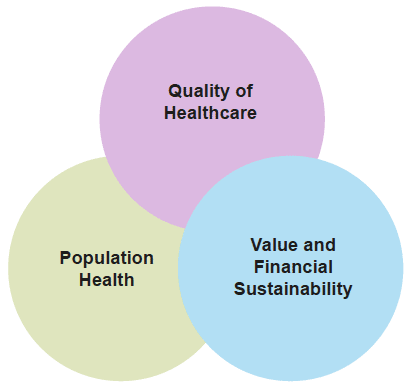Quality, Efficiency and Value: what Non-Executive Directors need to know
This resource provides an overview of 'quality, efficiency and value' within NHSScotland for Non-Executive Directors of Health Bodies.
Context
Efficiency and productivity
Efficiency is one of the six dimensions of quality.
The Institute of Medicine defines efficiency 'as avoiding waste, including waste of equipment, supplies, ideas, and energy'.
Efficiency and productivity can also be defined as follows:
| Efficiency | Productivity |
|---|---|
| Delivering the same results for a reduced input | Providing more for the same level of input |
| Lowering costs while maintaining service quality | Improving quality and/or quantity of service within existing budgets |
Efficiency and productivity are not about making cuts. They are about raising productivity, enhancing value for money and improving the quality of service by reducing waste and variation.
The Triple Aim - What is it?
Many of the world's best performing healthcare systems frame their ambition around the 'Triple Aim' of Quality of Care; Health of the Population and Financial Sustainability.
The Triple Aim is a framework that describes an approach to optimising health system performance through the simultaneous pursuit of three dimensions:
- Improving the quality of healthcare
- Improving the health of the population
- Achieving value and financial sustainability

Achieving value and financial sustainability
This document will focus on the value and financial sustainability axis of the Triple Aim.
Ensuring value for money, is about achieving a desired outcome at the least cost whilst maximizing the benefits to patients or the wider population from finite resources. Achieving value for money requires health services to be not only clinically effective but also cost-effective for agreed benefits.
NHSScotland has to continuously strive to improve in order to meet ongoing challenges such as: an ageing population, increasingly complex care needs, rising patient expectations and improving Scotland's public health record. Concepts such as reducing waste, variation and harm whilst increasing reliability, safety and person-centeredness are the drivers for focusing quality efforts in health care.
High performing healthcare organisations
When we look at healthcare organisations that are rising to these demands effectively, the evidence points to a number of key leadership characteristics which enable them to continue to respond to the efficiency and productivity challenge whilst increasing quality.
Through the study of organisations who deliver to high standards, some key attributes have been identified:
- Quality is a system property that requires a focus at multiple levels within the organisation. Quality is a social process and must focus on both the human dimensions of change as well as the science of improvement;
- There is impatience rather than satisfaction with current performance and constantly seeking to learn from others;
- Benchmarking is seen as an invaluable process as it helps to identify what good performance looks like;
- An enabling organisational structure and culture is core to delivery; and
- The journey to high performance is described at the highest level as a multi-phase and long term leadership objective.
Contact
Email: Sarah Hildersley
There is a problem
Thanks for your feedback